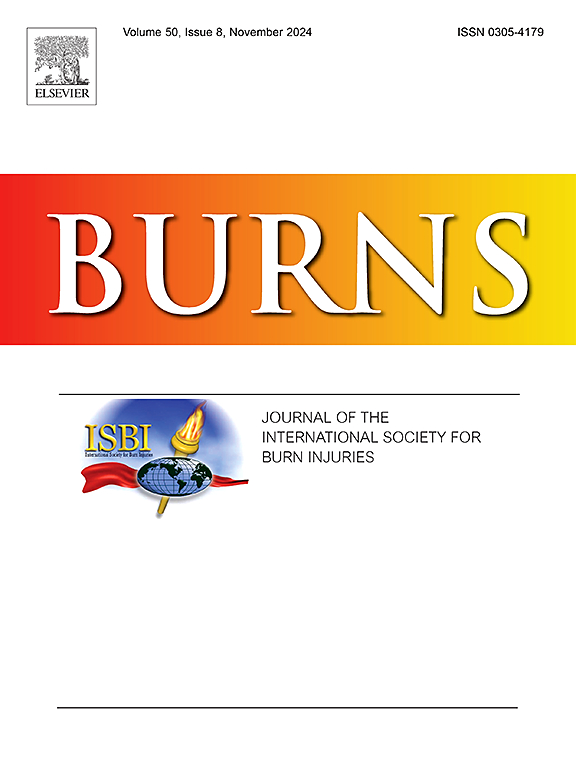黄貂鱼(雅科)肯。Walp。叶子衍生的生物纳米水凝胶加速大鼠糖尿病伤口愈合21天。
IF 3.2
3区 医学
Q2 CRITICAL CARE MEDICINE
引用次数: 0
摘要
本研究重点研究了黄刺草(Gliricidia sepium, Jacq.)的潜力。肯。Walp。叶子氧化锌纳米颗粒水凝胶(GSL ZnONPs HG)用于糖尿病伤口愈合。用高效液相色谱法分析了黄菖蒲的主要成分。肯。Walp。叶片乙醇提取物(GSL)为芹菜素-7- o -葡萄糖苷、山奈酚和原儿茶酸。这些化合物具有抗炎特性。以GSL乙醇提取物和水仙花(Gliricidia sepium, Jacq.)肯。Walp。叶片乙醇提取物氧化锌纳米颗粒(GSL ZnONPs)具有控释和良好的溶胀特性。GSL ZnONPs HG促进了糖尿病伤口的组织再生,减少了细胞凋亡,并调节了炎症,这是通过伤口形态学和闭合测量,以及组织病理学和免疫组织化学评估来证明的。重要的是要强调GSL ZnONPs的剂量依赖性行为,证明它们即使在较低浓度下也能有效促进糖尿病伤口愈合。这是通过血管细胞粘附分子-1 (VCAM-1)和晚期糖基化终产物水平(AGEs)的显着降低以及白细胞介素-10 (IL-10)和血小板衍生生长因子浓度(PDGF)的显着增加对各种生物标志物的反应来支持的。总的来说,该研究强调了GSL ZnONPs HG作为促进糖尿病伤口愈合的有希望的方法的潜力。本文章由计算机程序翻译,如有差异,请以英文原文为准。
Gliricidia sepium (Jacq.) Kunth. ex. Walp. leaves-derived biogenic nanohydrogel accelerates diabetic wound healing in rats over 21 days
This study focused on the potential of Gliricidia sepium (Jacq.) Kunth. ex. Walp. leaves zinc oxide nanoparticles hydrogel (GSL ZnONPs HG) for diabetic wound healing. The major components identified through HPLC analysis in Gliricidia sepium (Jacq.) Kunth. ex. Walp. leaves ethanolic extract (GSL) were apigenin-7-O-glucoside, kaempferol, and protocatechuic acid. These compounds exhibited anti-inflammatory properties. The hydrogel loaded with GSL ethanolic extract and Gliricidia sepium (Jacq.) Kunth. ex. Walp. leaves ethanolic extract zinc oxide nanoparticles (GSL ZnONPs) displayed controlled release and favorable swelling behavior. GSL ZnONPs HG enhanced tissue regeneration, reduced apoptosis, and modulated inflammation in diabetic wounds as demonstrated by wound morphology and closure measurements, as well as histopathological and immunohistochemical evaluations. It is important to highlight the dose-dependent behavior of GSL ZnONPs, demonstrating their effectiveness in promoting diabetic wound healing even at lower concentrations. This was supported by their response to various biomarkers through a significant reduction in vascular cell adhesion molecule-1 (VCAM-1) and advanced glycation end products levels (AGEs), and a notable increase in interleukin-10 (IL-10) and platelet-derived growth factor concentrations (PDGF). Collectively, the study highlights the potential of GSL ZnONPs HG as a promising approach to enhance diabetic wound healing.
求助全文
通过发布文献求助,成功后即可免费获取论文全文。
去求助
来源期刊

Burns
医学-皮肤病学
CiteScore
4.50
自引率
18.50%
发文量
304
审稿时长
72 days
期刊介绍:
Burns aims to foster the exchange of information among all engaged in preventing and treating the effects of burns. The journal focuses on clinical, scientific and social aspects of these injuries and covers the prevention of the injury, the epidemiology of such injuries and all aspects of treatment including development of new techniques and technologies and verification of existing ones. Regular features include clinical and scientific papers, state of the art reviews and descriptions of burn-care in practice.
Topics covered by Burns include: the effects of smoke on man and animals, their tissues and cells; the responses to and treatment of patients and animals with chemical injuries to the skin; the biological and clinical effects of cold injuries; surgical techniques which are, or may be relevant to the treatment of burned patients during the acute or reconstructive phase following injury; well controlled laboratory studies of the effectiveness of anti-microbial agents on infection and new materials on scarring and healing; inflammatory responses to injury, effectiveness of related agents and other compounds used to modify the physiological and cellular responses to the injury; experimental studies of burns and the outcome of burn wound healing; regenerative medicine concerning the skin.
 求助内容:
求助内容: 应助结果提醒方式:
应助结果提醒方式:


